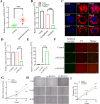LncRNA HCG18 regulates the progression of spinal tuberculosis by modulating the hsa-miR-146a-5p/TGF-β1/SMADs pathway
- PMID: 40390079
- PMCID: PMC12087226
- DOI: 10.1186/s13018-025-05810-3
LncRNA HCG18 regulates the progression of spinal tuberculosis by modulating the hsa-miR-146a-5p/TGF-β1/SMADs pathway
Abstract
Spinal tuberculosis is the most common extrapulmonary tuberculosis, characterized by intervertebral disc destruction, which seriously affects people's quality of life. Recent studies have suggested that the TGF-β1/SMADs signaling pathway plays an important regulatory role in the process of intervertebral disc destruction caused by spinal tuberculosis. However, the abnormal TGF-β1/SMADs signaling pathway in spinal tuberculosis is not fully understood. Herein, we found for the first time that HCG18 was significantly upregulated in spinal tuberculosis nucleus pulposus clinical samples and confirmed that HCG18 negatively regulates the proliferation and migration ability of nucleus pulposus cells (NPCs). In vitro experiments further suggest that overexpression of HCG18 can significantly promote TGF-β1/SMADs pathway activity and inhibit proliferation, migration, and apoptosis of NPCs, an effect which can be reversed by overexpressing hsa-miR-146a-5p. On the contrary, knocking down HCG18 yields the opposite result. In vivo experiments suggest that knocking down HCG18 can significantly alleviate the destruction of the nucleus pulposus in rats with spinal tuberculosis by inhibiting the activity of the TGF-β1/SMADs pathway. In summary, our research suggests that HCG18 can promote the progression of spinal tuberculosis by alleviating the inhibitory effect of hsa-miR-146a-5p on the TGF-β1/SMADs pathway. This study provides new insights into the occurrence and development of spinal tuberculosis, as well as new strategies for the prevention and treatment of spinal tuberculosis.
Keywords: HCG18; Intervertebral disc destruction; SMADs signaling pathway; Spinal tuberculosis; hsa-miR-146a-5p.
© 2025. The Author(s).
Conflict of interest statement
Declarations. Ethics approval and consent to participate: All experiments in the present study were under the ethical standards formulated in the Helsinki Declaration and were approved by the ethics committee of the First Affiliated Hospital of Weifang Medical University. Written informed consent was received from each participant. Disclosure statement: None. Competing interests: The authors declare no competing interests.
Figures








Similar articles
-
Inhibition of LncRNA FOXD3-AS1 suppresses the aggressive biological behaviors of thyroid cancer via elevating miR-296-5p and inactivating TGF-β1/Smads signaling pathway.Mol Cell Endocrinol. 2020 Jan 15;500:110634. doi: 10.1016/j.mce.2019.110634. Epub 2019 Oct 31. Mol Cell Endocrinol. 2020. PMID: 31678422
-
Long non-coding HCG18 promotes intervertebral disc degeneration by sponging miR-146a-5p and regulating TRAF6 expression.Sci Rep. 2017 Oct 16;7(1):13234. doi: 10.1038/s41598-017-13364-6. Sci Rep. 2017. PMID: 29038477 Free PMC article.
-
microRNA-539 functions as a tumor suppressor in papillary thyroid carcinoma via the transforming growth factor β1/Smads signaling pathway by targeting secretory leukocyte protease inhibitor.J Cell Biochem. 2019 Jun;120(6):10830-10846. doi: 10.1002/jcb.28374. Epub 2019 Jan 31. J Cell Biochem. 2019. Retraction in: J Cell Biochem. 2021 Nov;122 Suppl 1:S126. doi: 10.1002/jcb.30106. PMID: 30706537 Retracted.
-
Downregulation of lncRNA SBF2-AS1 inhibits hepatocellular carcinoma proliferation and migration by regulating the miR-361-5p/TGF-β1 signaling pathway.Aging (Albany NY). 2021 Aug 2;13(15):19260-19271. doi: 10.18632/aging.203248. Epub 2021 Aug 2. Aging (Albany NY). 2021. PMID: 34341185 Free PMC article.
-
Silencing lncRNA Snhg6 mitigates bleomycin-induced pulmonary fibrosis in mice via miR-26a-5p/TGF-β1-smads axis.Environ Toxicol. 2022 Oct;37(10):2375-2387. doi: 10.1002/tox.23603. Epub 2022 Jul 4. Environ Toxicol. 2022. PMID: 35785413
References
MeSH terms
Substances
Grants and funding
- ZR2020MH093/Natural Science Foundation of Shandong Province
- SZSM202111015/Sanming Project of Medicine in Shenzen Municipality
- RCYX20231211090329027, JCYJ20220530152812028/Shenzhen Municipal Science and Technology Innovation Committee Project
- A2303029/Shenzhen Medical Academy of Research and Translation Project
- SZXK024/Shenzhen Key Medical Discipline Construction Fund
LinkOut - more resources
Full Text Sources
Miscellaneous

